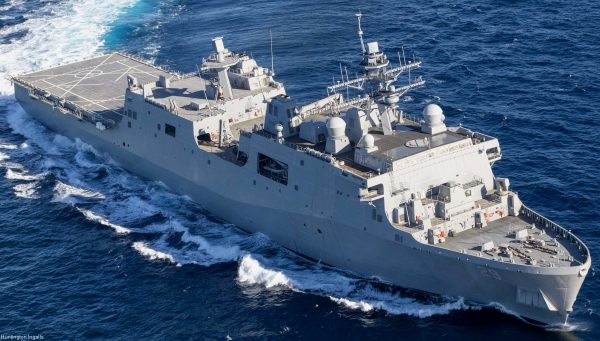The following article first appeared on Warrior Maven, a Military Content Group member website.
Attacks from ship to shore, weapons and Marines transport, drone control, and the ability to project stealthy 5th-generation airpower from the sea in support of amphibious operations .. are a few of the many operations performed by the Navy’s amphibious assault fleet. With Combatant Commander demand for Amphibious Ready Groups, Marine Expeditionary Units and Marine Corps Air-Ground Task Forces increasing, the Navy is working intensely with Congress to add amphibs to the fleet.
At the moment, Congressionally authorized legislation mandates that the Navy and Marine Corps operate at least 31 amphibious assault ships, yet the benchmark has proven illusive amid funding complications and the pace at which legacy vessels are being decommissioned. The minimum required number of amphibious assault ships has fluctuated over the years, as many previous Marine Corps and Congressional leadership have mandated at least 38 amphibs, and the actual number required has routinely exceeded this amount. Simply put, the need for amphibs continues to outpace the available supply, something the Corps is working intensely to correct. Many current and former Navy and Marine Corps leaders emphasize that the current global threat environment is extremely severe, a circumstance requiring the operational versatility and lethality that arguably can only be provided by amphibious assault ships.
“Legislation mandating minimum fleet sizes in total or by category is a worthy effort, but in itself reflects the extent of our challenge. We are arguing about ‘minimums’ when we should be working towards ‘maximums’ if we want to be prepared to win the great power conflict of the 21st century,” Ret. Maj. Gen. David Coffman, former Director of Expeditionary Warfare for the Navy, and senior expert Navy advisor for Warrior, said in an interview.
In an effort to address this deficit and begin to close the massive abyss separating operational demand for amphibs from available ships, the Navy and Congress have implemented a “block buy” strategy to place as many as four amphibious assault ships under contract at one time. The intent is to ensure that at least one new amphibious assault ship can be delivered every two years on a regular anticipated schedule. For instance, the service just commissioned LPD 29, an Amphibious Transport Dock expected to bring ship-to-shore power projection and multi-domain connectivity to the force. LPD 30 is slated to emerge in 2026 and, according the the emerging defense bill, LPD 33 is slated to arrive in 2025, LPD 34 by 2027 and LPD 35 in 29, provided Congress ultimately approves funding for the timeline.
“For the Navy it means restoring the number of amphibs the Corps will need. For the industrial base we need that predictability so suppliers can plan for the work ahead and not have to lay off working. Our main message is that with predictable and steady funding our members can invest more into R&D and through that it becomes innovation,” Paul Roden, Chairman of the Amphibious Warship Industrial Base Coalition, told Warrior in an interview. “This is historic for the amphibious warship industrial base. Our suppliers have been advocating for a multi-ship buy for years. So, we are thrilled to see lawmakers, the Navy and Marine-Corps listen to our concerns and reach this deal, which will provide the predictable funding that our suppliers urgently need,”
As an advocate for a large shipbuilding industrial base of more than 650 companies spanning across 39 US states, Roden detailed additional benefits associated with block buys related to innovation and modernization.
“Not only will this block buy save the taxpayers… nearly $1 billion, but it will provide companies the stability we need to invest in our skilled workforce, get ahead of inflation and ensure on time deliveries. The companies of the amphibious warship industrial base are extremely proud of their contributions to our national security and will deliver the highest quality parts and services for these future amphibious warships,” Roden said.
The following article first appeared on Warrior Maven, a Military Content Group member website.
Attacks from ship to shore, weapons and Marines transport, drone control, and the ability to project stealthy 5th-generation airpower from the sea in support of amphibious operations .. are a few of the many operations performed by the Navy’s amphibious assault fleet. With Combatant Commander demand for Amphibious Ready Groups, Marine Expeditionary Units and Marine Corps Air-Ground Task Forces increasing, the Navy is working intensely with Congress to add amphibs to the fleet.
At the moment, Congressionally authorized legislation mandates that the Navy and Marine Corps operate at least 31 amphibious assault ships, yet the benchmark has proven illusive amid funding complications and the pace at which legacy vessels are being decommissioned. The minimum required number of amphibious assault ships has fluctuated over the years, as many previous Marine Corps and Congressional leadership have mandated at least 38 amphibs, and the actual number required has routinely exceeded this amount. Simply put, the need for amphibs continues to outpace the available supply, something the Corps is working intensely to correct. Many current and former Navy and Marine Corps leaders emphasize that the current global threat environment is extremely severe, a circumstance requiring the operational versatility and lethality that arguably can only be provided by amphibious assault ships.
“Legislation mandating minimum fleet sizes in total or by category is a worthy effort, but in itself reflects the extent of our challenge. We are arguing about ‘minimums’ when we should be working towards ‘maximums’ if we want to be prepared to win the great power conflict of the 21st century,” Ret. Maj. Gen. David Coffman, former Director of Expeditionary Warfare for the Navy, and senior expert Navy advisor for Warrior, said in an interview.
In an effort to address this deficit and begin to close the massive abyss separating operational demand for amphibs from available ships, the Navy and Congress have implemented a “block buy” strategy to place as many as four amphibious assault ships under contract at one time. The intent is to ensure that at least one new amphibious assault ship can be delivered every two years on a regular anticipated schedule. For instance, the service just commissioned LPD 29, an Amphibious Transport Dock expected to bring ship-to-shore power projection and multi-domain connectivity to the force. LPD 30 is slated to emerge in 2026 and, according the the emerging defense bill, LPD 33 is slated to arrive in 2025, LPD 34 by 2027 and LPD 35 in 29, provided Congress ultimately approves funding for the timeline.
“For the Navy it means restoring the number of amphibs the Corps will need. For the industrial base we need that predictability so suppliers can plan for the work ahead and not have to lay off working. Our main message is that with predictable and steady funding our members can invest more into R&D and through that it becomes innovation,” Paul Roden, Chairman of the Amphibious Warship Industrial Base Coalition, told Warrior in an interview. “This is historic for the amphibious warship industrial base. Our suppliers have been advocating for a multi-ship buy for years. So, we are thrilled to see lawmakers, the Navy and Marine-Corps listen to our concerns and reach this deal, which will provide the predictable funding that our suppliers urgently need,”
As an advocate for a large shipbuilding industrial base of more than 650 companies spanning across 39 US states, Roden detailed additional benefits associated with block buys related to innovation and modernization.
“Not only will this block buy save the taxpayers… nearly $1 billion, but it will provide companies the stability we need to invest in our skilled workforce, get ahead of inflation and ensure on time deliveries. The companies of the amphibious warship industrial base are extremely proud of their contributions to our national security and will deliver the highest quality parts and services for these future amphibious warships,” Roden said.
Need for Amphibs
As a former Commander of MAGTFs and MEUs, Coffman argues that there are many operational advantages perhaps only offered by amphibs, such as the fast-growing ability of mother-ship big-deck amphibs to operate growing numbers of air, surface and undersea drones. The Concept of Operation is clear, as large America-class Amphibious Assault Ships or even LPDs engineered with advanced command and control can leverage cutting edge AI and command and control technology to operate small fleet of drones in position to conduct forward reconnaissance, identify enemy targets and even launch offensive strikes when directed by a human. Years ago, Coffman argued that indeed “bigs” or large-deck mothership amphibs could perform command and control over hundreds of unmanned systems, a tactical vision which has increasingly been coming to fruition in recent years. This supports and further enables the Navy’s Distributed Maritime Operations strategy which recognizes that extremely well-networked manned and unmanned surface ships can operate in a disaggregated fashion to increase survivability and widen an operational envelope. These emerging Navy Concepts of Operation have been in development for many years, as the service has engineered the most current LPD Flight II amphibs with additional command and control, communications and networking technology to support more dispersed operations. Instead of needing to operate in close proximity to its partner ships in an Amphibious Ready Group alongside Dock Landing Ships and big-deck amphibs, LPDs can also increasingly operate more autonomously while maintaining secure networking. A less condensed fleet is not only a smaller and less vulnerable target for potential adversaries, but it can also vastly expand the operational envelope. Flight II LPDs have been outfitted with a new generation of antennas and other advanced networking technologies to support distributed operations.



